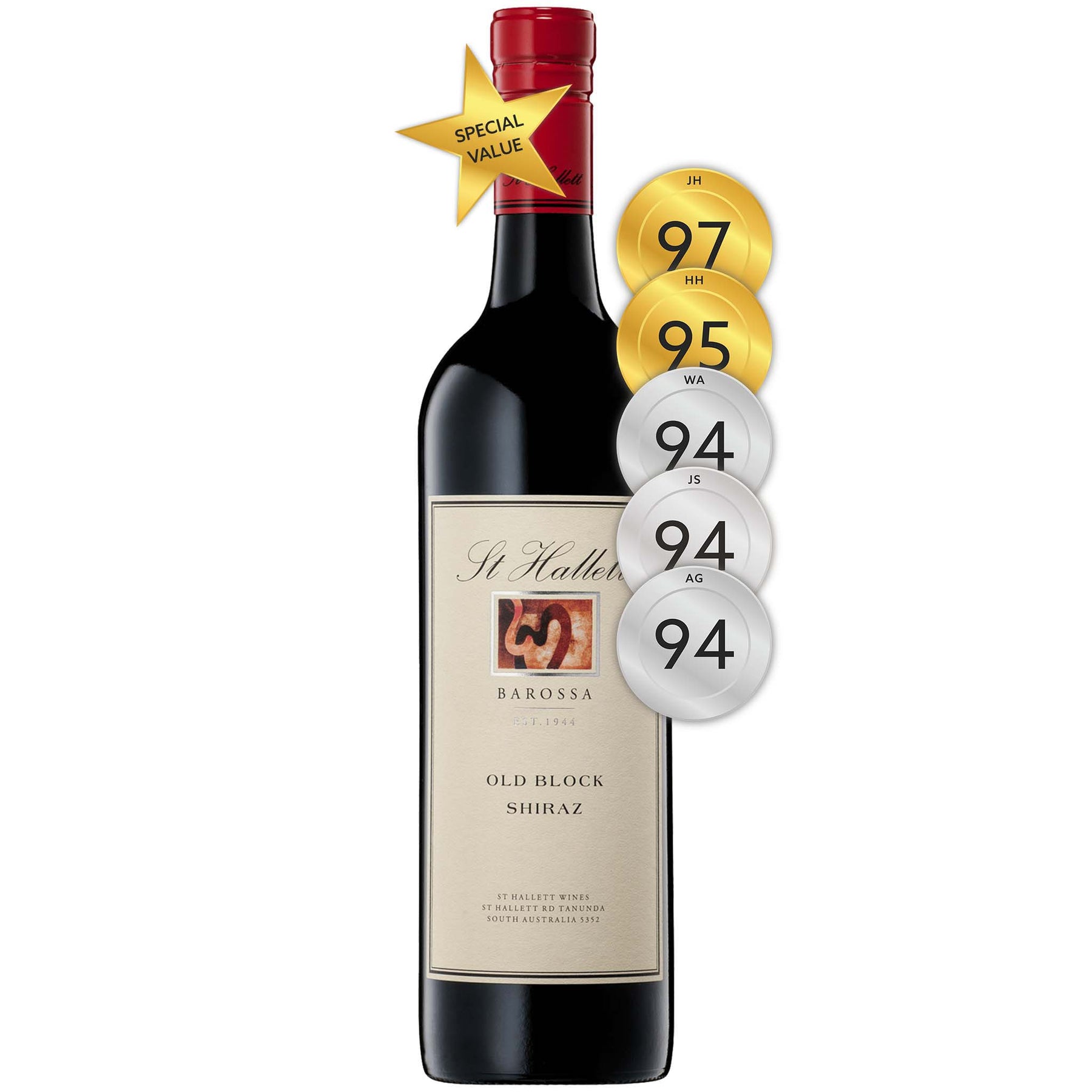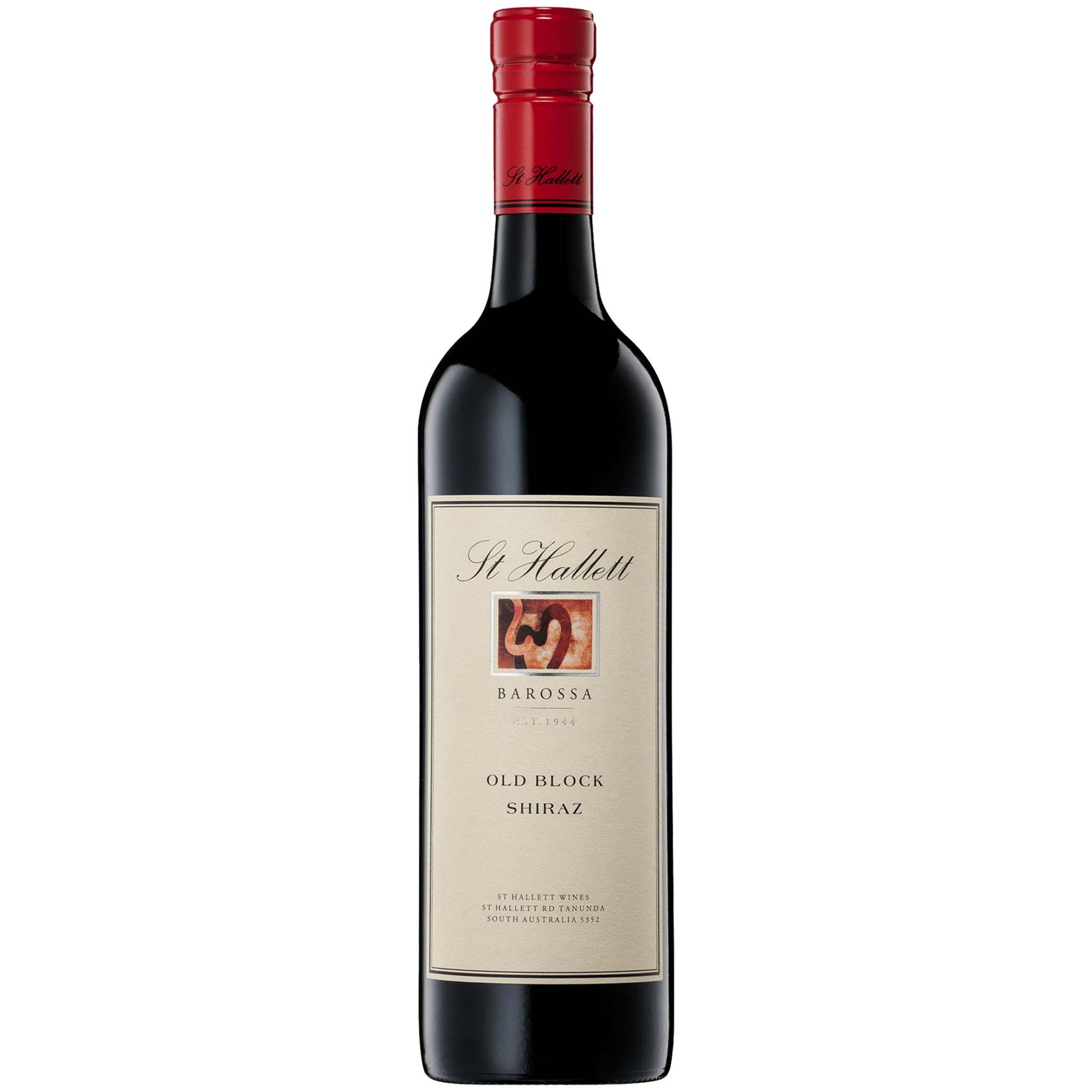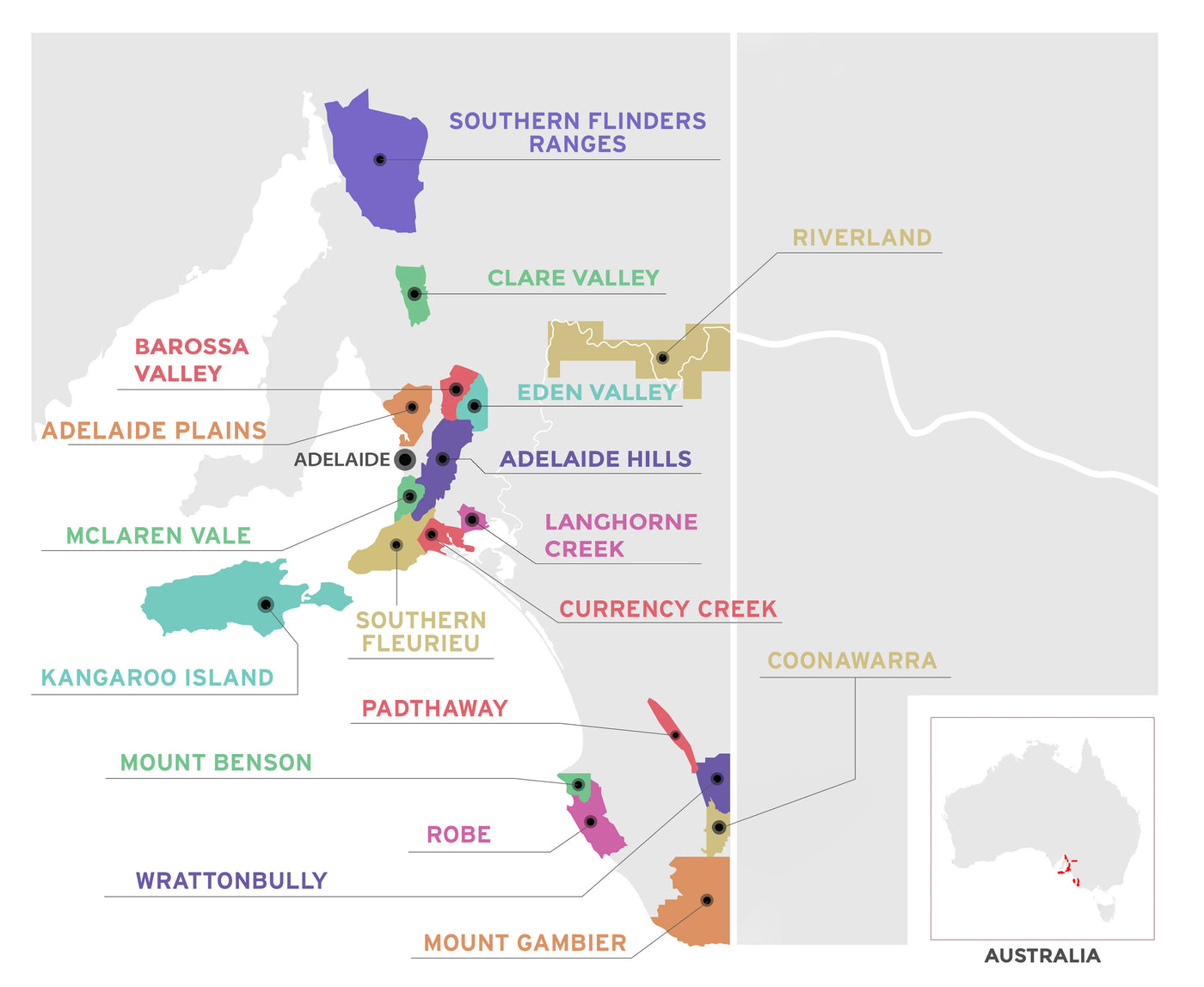

St Hallett Old Block Shiraz 2016
Style: Red Wine
Variety: Shiraz
Closure: Cork
St Hallett Old Block Shiraz 2016
Warehouse
34 Redland Drive
Vermont VIC 3133
Australia
Critic Score: 97
Alcohol: 14.6%
Size: 750 ml
Drink by: 2045
This is the flagship of St Hallett's wines and has become one of the great icons of Australian wine. The 2016 Old Block Shiraz is a blend of fruit from the Barossa Valley (51%) and the Eden Valley (49%). The average age of the vines is 92 years old. The Barossa component provides the fundamental core of blackberry fruit, while the higher altitude Eden Valley component adds the cooler climate spicy elements and some savoury texture.
"Very deep, youthfully bright purple/red colour, the bouquet savoury, oak-tinged and coconutty, shouting American oak. The wine is full-bodied and firm, loaded with flavour and backed by a firm spine of tannins, some of which are oaky. Good depth, concentration and fleshiness: it just needs time." Huon Hooke
"Originally from the St Hallett Old Block vineyard this wine was first made by Robert O’Callaghan and Stuart Blackwell in 1980. To qualify for Old Block Shiraz the vineyards must be planted on their own rootstock and be more than 50 years old. The oldest vineyard used to create the 2016 Old Block was planted in 1856 whilst the youngest 1963, with an average of 92 years.
Now, with the 34th vintage release, the wine has evolved from a single block into a selection of the best old blocks from the Barossa and Eden Valleys. As the fruit is sourced from around five growers in Barossa and Eden Valleys each parcel comes to the winery and is fermented separately. Once the wine achieves balance on tasting it is pressed off skins and goes directly to barrel where it will age for 12-18 months. Prior to blending each barrel is assessed for balance and flavour integration to ensure absolute premium quality in the final wine." Helen McCarthy, Chief Winemaker
"Vibrant crimson appearance with slight brick hue. A vibrant and lifted bouquet of dark cherry, raspberry and violets, with notes of cinnamon, nutmeg and slight camphor-like character also present. Elegant and incredibly well integrated. Full bodied and silky with the trademark seamlessness of Old Block. Immediately on the palate are rich dark fruits, and layers of dark and black cherry, while anise and hints of white pepper slowly unfold. Beautifully balanced acid and tannin with a long, supple finish. Peak drinking: 2040 – 2050." St Hallett
Expert reviews
"92yo vines, hand-picked, tank and open fermenters, 10 days on skins, matured in French hogsheads and puncheons (25% new) for 18 months. As magnificently rich and deeply flavoured as expected. Blackberry and blackcurrant, then a move to licorice, onto cedary oak and supple tannin providing texture and structure. Drink by 2046." James Halliday, Halliday Wine Companion - 97 points and Special Value Wine ★
"Very deep, youthfully bright purple/red colour, the bouquet savoury, oak-tinged and coconutty, shouting American oak. The wine is full-bodied and firm, loaded with flavour and backed by a firm spine of tannins, some of which are oaky. Good depth, concentration and fleshiness: it just needs time. Drink 2022-2036." Huon Hooke, The Real Review - 95 points
"This has aromas of camphor, blueberry, blackberry and spiced plum, as well as black tea, violet and bergamot. The palate has a very plush, intense feel with rich blackberries, framed in nicely tailored tannins. Medium to full body. Will age well. Try from 2024." James Suckling, JamesSuckling.com - 94 points
"Deep, purple/red fruited, the oak a coffeed background shade, the palate ripe and blueberried, plush, round, and alcoholic. It’s not heavy, not hearty, more plush. Enjoyable too. But then it finishes tart, a bit warm and round. It says 'I love you' but the hug is a bit perfunctory. Generous, but a little simple too. I admire the length, the concentration, the Barossa black fruit core. This is indeed quality wine, hence the gold medal score. But I think I’ve loved previous vintages just a little bit more. Best drinking: now and for at least 15 years." Andrew Graham, Australian Wine Review – 94 points
"Compared to the two other St Hallett Shiraz offerings, the 2016 Old Block Shiraz delivers an extra level of intensity. Mixed red and black berry fruit comes across as a bit tart and structured, clearly meant for aging. It's full-bodied but angular at this age, with the fine-grained tannins showing a bit too prominently for current consumption. Despite the name, it's actually a blend of old-vine parcels in both the Barossa Valley (51%) and Eden Valley (49%), the youngest having been planted in 1963, while the oldest dates to 1856. Drink: 2023 - 2035." Joe Czerwinski, Wine Advocate - 94 points
Awards
Special Value Wine – Halliday Wine Companion ★
Helen McCarthy

When a young Helen moved with her family from England to Australia in 1988, she had no idea what her future would hold. She had an interest in science, but on her 18th birthday, she was persuaded to enrol in an oenology degree at the University of Adelaide and never looked back. Helen graduated with first class honours in 2000, and has since enjoyed a steady climb to the top of her profession.
On completion of her degree she joined Southcorp Wines and worked at Lindemans, Wynns Coonawarra Estate, Seppelt and Penfolds. In late 2002, she joined Taylors Wines in the Clare Valley. She spent eight years at Taylors, the last six in the coveted role of Senior Winemaker. Less than a decade after she graduated, she was recognised as one of Australia’s brightest winemaking talents, winning two Young Winemaker of the Year awards in 2008. She followed these up with two more in 2013.
In late 2011, the calling of home - Barossa - saw Helen move to Thorn-Clarke Wines as Senior Winemaker. She helped lead a new generation of Barossa winemakers and her 2012 Ron Thorn Shiraz was named 'The Best Shiraz in the World' at the prestigious International Wine and Spirit Competition. Helen particularly loved the region's strong sense of community and commitment to sustainability. Helen's time at Thorn-Clarke ignited a passion for Eden Valley, and in 2015, she took up the position of Chief Winemaker at Mountadam Vineyards. The focus during her time at Mountadam was on lifting the profile of the winery.
In late 2019, a once-in-a-lifetime opportunity arose, and Helen joined St Hallett as Senior Winemaker. This led to her being promoted to the role of Director of Global Winemaking for Vinarchy in 2025, following the merger of Accolade Wines and Pernod Ricard Winemakers. Vinarchy is home to a range of global brands led by Hardys, Campo Viejo and Jacob’s Creek, and domestic brands including St Hallett.
The following interview is taken from https://wineriesofsouthaustralia.com.au/meet-the-winemaker-helen-mccarthy/
When did you realise you wanted to become a winemaker?
It was when I was eighteen and finalising my course choice for university. I had put down pure science degrees until my best friend suggested winemaking. He got one of his wine marketing subject lecturers to call me, and we talked for two hours about the industry, winemaking, and his passion for said industry. He infected me with the wine industry bug and I changed my preferences at the twelfth hour. Luckily, I got in and enrolled on my eighteenth birthday and I haven’t looked back!
Please tell us about your career so far
I have a Bachelor of Agricultural Science (Oenology) with First Class Honours and a Master of Business Administration. When I finished my undergraduate degree I joined Southcorp Wines as a graduate winemaker and spent time at Lindeman’s Wines in Mildura, Wynns in Coonawarra, Seppelt Great Western in the Grampians and Penfolds in the Barossa.
In late 2002, I took a position as winemaker at Taylors Wines in the Clare Valley. The eight-year period that I was at Taylors was a massive growth period, and after two years I was promoted to senior winemaker.
The calling of home – Barossa – was too strong, and I began working for Thorn-Clarke Wines in late 2011 as senior winemaker/manager. The role included managing a vineyard estate of 280-hectares. Working at Thorn-Clarke sparked a passion in me for Eden Valley.
In 2015, I took on the role of chief winemaker at Mountadam Vineyards. The focus during my time at Mountadam was on not only chardonnay but also on lifting the profile of Mountadam’s red wines. I loved being part of a small, tight-knit team of people who were passionate about maintaining such an iconic
and important brand to the Australian wine industry. In late 2019 I was presented with the opportunity of joining St Hallett as senior winemaker and manager.
What do you love most about being a winemaker?
I love the variety in the job – I get to walk around the vineyards, get my hands dirty, and use science and art to produce something. I also get to travel and eat and drink in places that I probably couldn’t [otherwise] afford! What’s not to love?
What is your favourite wine, and what food do you typically pair it with?
My favourite variety is riesling, I love the purity and diversity of style. Typically I’ll drink a glass by itself, but it’s also great with a range of dishes from salad right through to spicy curries.
Is there a specific process you follow when developing a new wine?
My brain is quite creative, but my personality is more structured so the process I follow is to look at what is already on the market (that may be within Australia and also outside Australia). From there, it’s to taste as many different wines as I possibly can, and learn as much about that target style or variety as I can. Then I create a style brief that considers what I’m trying to achieve and what I have at my disposal. This brief includes key descriptors about how the wine should smell, taste and feel. Then it’s about spending lots of time planning how we are going to achieve that brief, doing it, and then blending and finishing the wine off.
Is there any vintage you’re particularly proud of creating? Why?
The 2021 vintage is in my mind, the best one I’ve ever been involved in – everything is just amazing. I’m proud of the wines we’ve created, but we really can’t take the credit. In reality, all the stars aligned!
How does the local climate/soil affect the wine you make?
Local climate and soil has a significant effect on the wines that we make. There is a massive difference between fruit sourced in different areas of the Barossa, or even within the same vineyard. It’s our job to highlight and respect these differences – our aim is not to make everything look the same.
Which of your own varieties do you typically indulge in?
At the moment, I’m enjoying a lot of the 2018 St Hallett Higher Earth Syrah and a new release, which is a new take on what it means to be a Barossa shiraz – 2021 St Hallett Blockhead Shiraz Nouveau.
Where do you see yourself in five years? How do you think your winemaking will evolve during this time?
[In five years] I’m planning to still be making wine at St Hallett – still learning about Barossa shiraz and finessing our approach to making outstanding wines that have a sense of place, and that respect the vineyard they were sourced from.
About the winery

Established in 1944 by the Lindner Family, St Hallett represents the very spirit and soul of winemaking in the Barossa. For most of that time it was owned, or part-owned, by one family, the pioneering Lindners, who arrived in the Barossa from Silesia in 1838. In 2017, St Hallett was acquired by Accolade.
St Hallett sources all grapes from within the Barossa and is synonymous with the region's icon variety, shiraz. From the beginning, St Hallett understood the importance of saving old vines and focusing on varieties that thrive in the Barossa region. Strong long-term relationships with focused and passionate growers give St Hallett access to the Barossa's most prized vineyards, some of which were planted over 100 years ago. Over the years, St Hallett has built up a deep understanding of the rich tapestry of vineyard sites and climates in the Barossa and sources the finest vines and highest-quality parcels of fruit the Barossa can offer.
Old Block Shiraz (using grapes from Lyndoch and Eden Valley) is their flagship wine, supported by Blackwell Shiraz (using grapes from Greenock, Ebenezer and Moppa Hills).


South Australia
South Australian is responsible for more than half the production of all Australian wine. It is home to more than 900 wineries across 18 wine regions. The regions are Adelaide Hills, Adelaide Plains, Barossa Valley, Clare Valley, Coonawarra, Currency Creek, Eden Valley, Kangaroo Island, Langhorne Creek, McLaren Vale, Mount Benson, Mount Gambier, Padthaway, Riverland, Robe, Southern Fleurieu, Southern Flinders Ranges and Wrattonbully.
Many of the well-known names in the South Australian wine industry established their first vineyards in the late 1830s and early 1840s. The first vines in McLaren Vale were planted at Reynella in 1839 and Penfold's established Magill Estate on the outskirts of Adelaide in 1844.
South Australia has a vast diversity in geography and climate which allows the State to be able to produce a range of grape varieties - from cool climate Riesling in the Clare and Eden Vallies to the big, full bodied Shiraz wines of the Barossa Valley and McLaren Vale. Two of Australia's best-known wines, Penfolds Grange and Henschke Hill of Grace, are produced here. There is much to discover in South Australia for the wine lover.
